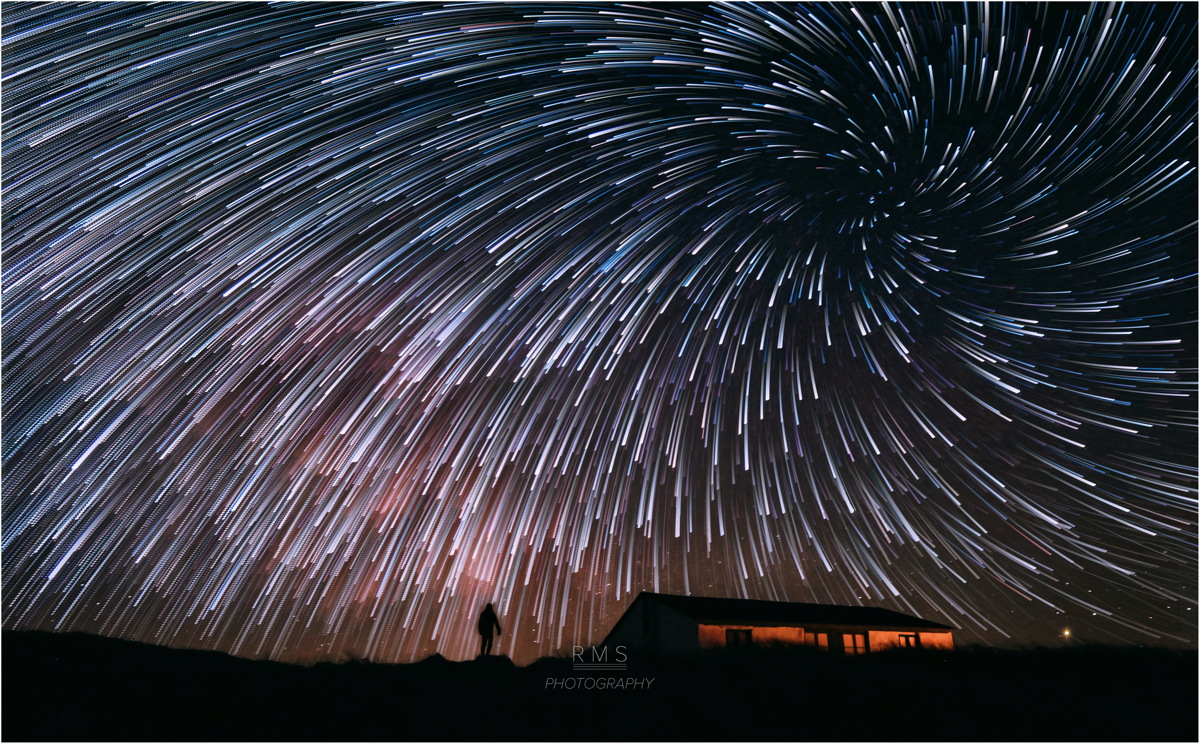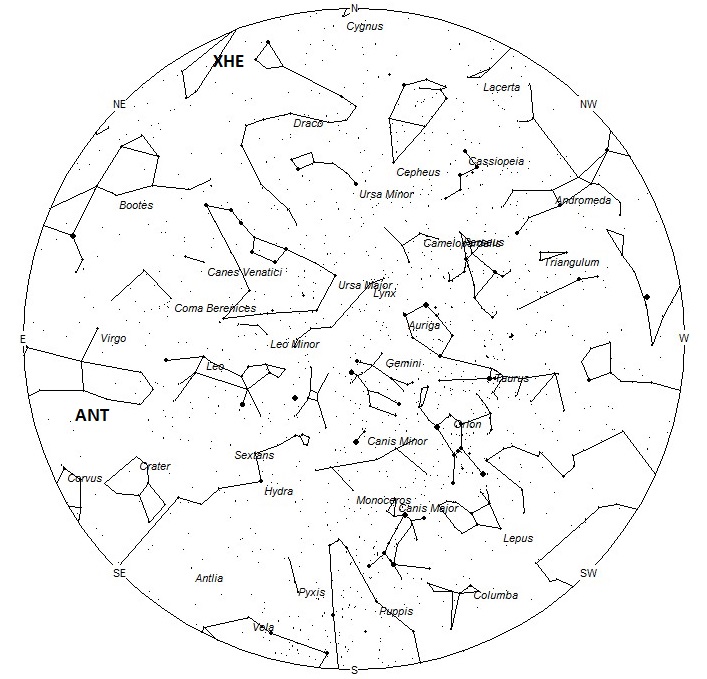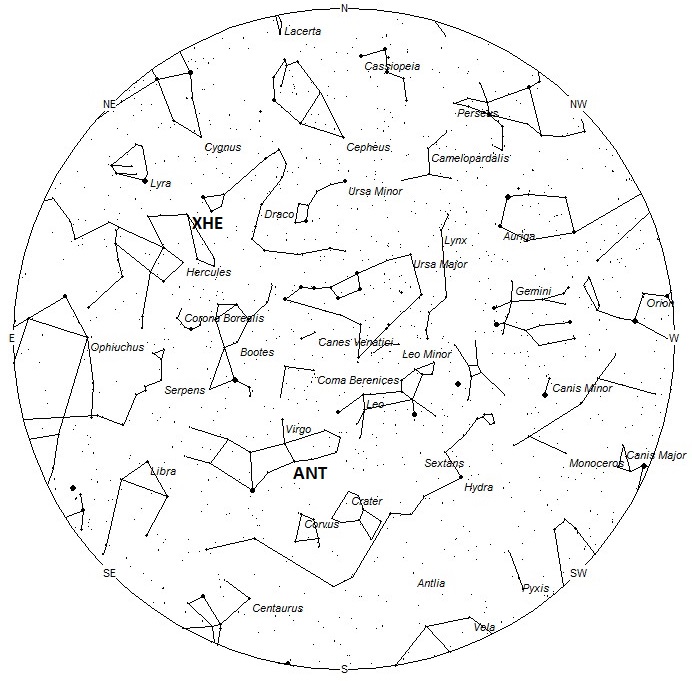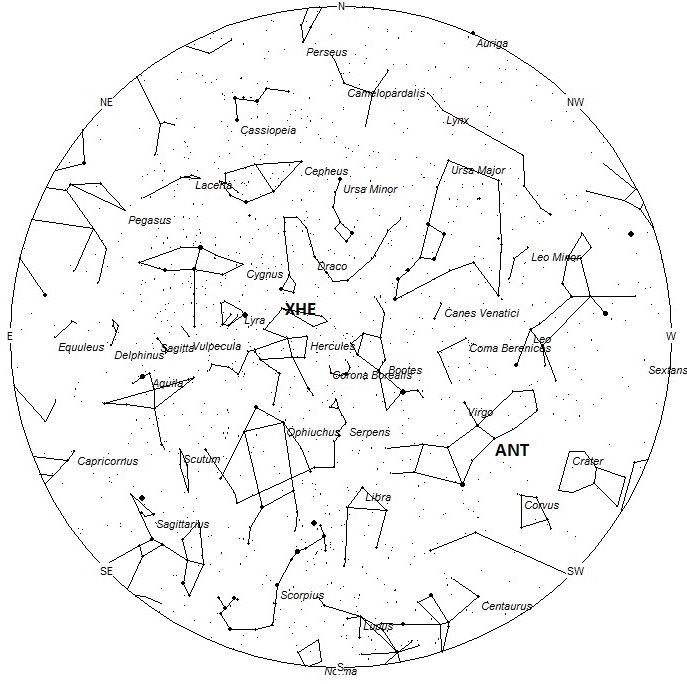
© Ruslan Merzlyakov – Vortex of star trails created using Photoshop – Stenbjerg, Thy National Park, Denmark. March 2015.
During this period the moon will reach its new phase on Friday March 20th. At this time the moon is located near the sun and is invisible at night. This weekend the waning crescent moon will rise during the early morning hours and will interfere with meteor observing if not kept out of ones field of view. Viewing conditions improve with each passing morning as the moon’s phase wanes and it rises later each morning. The estimated total hourly meteor rates for evening observers this week is near 3 for observers situated at mid-northern latitudes and 4 for observers viewing from the southern tropics (latitude 25 S.). For morning observers the estimated total hourly rates should be near 6 for observers situated at mid-northern latitudes and 8 for observers viewing from the southern tropics. Morning rates are slightly reduced during this period due to lunar interference. The actual rates will also depend on factors such as personal light and motion perception, local weather conditions, alertness and experience in watching meteor activity. Note that the hourly rates listed below are estimates as viewed from dark sky sites away from urban light sources. Observers viewing from urban areas will see less activity as only the brightest meteors will be visible from such locations.
The radiant (the area of the sky where meteors appear to shoot from) positions and rates listed below are exact for Saturday night/Sunday morning March 14/15. These positions do not change greatly day to day so the listed coordinates may be used during this entire period. Most star atlases (available at science stores and planetariums) will provide maps with grid lines of the celestial coordinates so that you may find out exactly where these positions are located in the sky. A planisphere or computer planetarium program is also useful in showing the sky at any time of night on any date of the year. Activity from each radiant is best seen when it is positioned highest in the sky, either due north or south along the meridian, depending on your latitude. It must be remembered that meteor activity is rarely seen at the radiant position. Rather they shoot outwards from the radiant so it is best to center your field of view so that the radiant lies at the edge and not the center. Viewing there will allow you to easily trace the path of each meteor back to the radiant (if it is a shower member) or in another direction if it is a sporadic. Meteor activity is not seen from radiants that are located below the horizon. The positions below are listed in a west to east manner in order of right ascension (celestial longitude). The positions listed first are located further west therefore are accessible earlier in the night while those listed further down the list rise later in the night.
These sources of meteoric activity are expected to be active this week.
The center of the large Anthelion (ANT) radiant is currently located at 12:28 (187) -04. This position lies in western Virgo, 4 degrees southwest of the famous 3rd magnitude double star known as Porrima (Gamma Virginis). Due to the large size of this radiant, Anthelion activity may also appear from Corvus, Crater, eastern Leo as well as western Virgo. This radiant is best placed near 0100 local daylight saving time (DST), when it lies on the meridian and is located highest in the sky. Rates at this time should be near 2 per hour no matter your location. With an entry velocity of 30 km/sec., the average Anthelion meteor would be of slow velocity.
The last of the Xi Herculids (XHE) should be seen this weekend from a radiant located at 17:12 (258) +48. This position is located in extreme northern Hercules, 4 degrees southwest of the 3rd magnitude star known as Rastaban (Beta Draconis). This radiant is best placed during the last hour before dawn when it lies highest above the horizon in a dark sky. Rates at this time should be less than 1 per hour no matter your location. With an entry velocity of 35 km/sec., the average meteor from this source would be of medium-slow velocity.
As seen from the mid-northern hemisphere (45N) one would expect to see approximately 4 sporadic meteors per hour during the last hour before dawn as seen from rural observing sites. Evening rates would be near 2 per hour. As seen from the tropical southern latitudes (25S), morning rates would be near 6 per hour as seen from rural observing sites and 3 per hour during the evening hours. Locations between these two extremes would see activity between the listed figures. Morning rates are slightly reduced during this period due to moonlight.
The list below offers the information from above in tabular form. Rates and positions are exact for Saturday night/Sunday morning except where noted in the shower descriptions.
| SHOWER | DATE OF MAXIMUM ACTIVITY | CELESTIAL POSITION | ENTRY VELOCITY | CULMINATION | HOURLY RATE | CLASS |
| RA (RA in Deg.) DEC | Km/Sec | Local Daylight Saving Time | North-South | |||
| Anthelions (ANT) | – | 11:32 (173) +02 | 30 | 02:00 | 2 – 2 | II |
| Xi Herculids (XHE) | Mar 12 | 17:12 (258) +48 | 35 | 08:00 | <1 – <1 | IV |
 American Meteor Society
American Meteor Society



In the early hours of my birthday, Sunday March 8th, in my garden in Oxford, England, I saw a meteor. It was appeared to be an oval shape, bright white with a green halo, it shot across the sky, I think roughly from east to west and was quite large. Sadly no camera on me and no-one else saw it, I happened to be crossing the garden to my yurt at the time.
I just saw a meteor here in Texas about 10 or 15 minutes ago. I happened to look out my window just in time to see it. It was bright orange and shot across the sky pretty horizontally. It was absolutely beautiful!! And bigger than any other meteor I’ve seen!
Saw a few meteor s above erie pa about 5
Starry night march 21 also my anniversary saw them
About10:30 pm